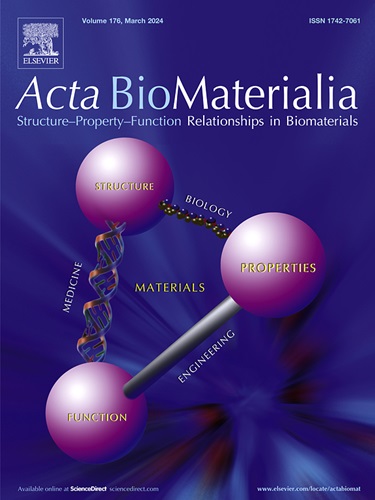基于磁性弹性体的动态尿道支撑装置,用于治疗压力性尿失禁。
IF 9.4
1区 医学
Q1 ENGINEERING, BIOMEDICAL
引用次数: 0
摘要
压力性尿失禁(SUI)是指在用力时腹内压力增加而导致的不自主漏尿。治疗 SUI 的常用方法是在尿道下方植入吊带以提供支撑。然而,目前的吊带术无法在术后调整尿道张力。为了解决这一局限性,我们设计了一种软磁活性弹性体(MAE)装置,能够在中等磁场作用下改变形状。为了确保纤维化瘢痕组织包裹后的形状变化,我们将 MAE 装置嵌入不同硬度的琼脂凝胶中,并研究了它们在高达 200 mT 磁场下的形状变化。设计了一个简单的下尿路体外模型来研究装置的性能。在用手持磁铁激活吊索前后,模拟膀胱系统发生泄漏时,测量了流量时间与压力的函数关系。嵌入琼脂凝胶(100 kPa)中的 MAE 装置呈吊床状配置,高度变化率为 4.7% ± 1.1%。在加速氧化(2.36% ± 1.55%)和水解(0.58% ± 0.25%)条件下,带有二氧化硅涂层磁性颗粒的装置在两周后的质量损失极小。在模型尿道下放置吊带可提供尿道支撑,从而增加其流动阻力。应用磁场时,归一化流动时间从 1.56 ± 0.18 显著减少到 1.11 ± 0.16,这表明在 60 cm-H2O 条件下尿道支撑力发生了调节。这种动态吊衣通过生理安全磁场从外部供电,可在下尿路模型中实现尿道支撑调节。意义说明:压力性尿失禁(SUI)影响着半数成年女性的一生,吊衣常用于治疗严重病例。虽然吊带植入术创伤小,治愈率高,但长期吊带并发症(如尿潴留)仍是一个重大问题。现有的可调节 SUI 设备通常需要进行侵入性手术、植入电子元件和多个机械部件,从而增加了整体侵入性。在此,我们报告了一项概念验证,即使用形状变形生物材料制造一种动态装置,该装置可提供尿失禁支持,并可在触发后改变形状,从而实现完全排尿。这种动态装置可以避免许多与传统吊带相关的并发症,提高严重 SUI 妇女的生活质量。本文章由计算机程序翻译,如有差异,请以英文原文为准。

Magnetoactive elastomer-based dynamic urethral support device for stress urinary incontinence
Stress urinary incontinence (SUI) is the involuntary leakage of urine in response to increased intra-abdominal pressure during episodes of exertion. A common treatment method for SUI is sling implantation underneath the urethra to provide support. Most current sling procedures, however, cannot adjust urethral tension postoperatively. To address this limitation, we designed a soft magnetoactive elastomer (MAE) device capable of changing shape in response to moderate magnetic fields. To ensure shape change after fibrotic scar tissue encapsulation, MAE devices were embedded in agar gels with different stiffnesses, and their shape change was studied in response to up to 200 mT magnetic fields. A simple in vitro model of the lower urinary tract was designed to study device performance. Flow time was measured as a function of pressure in the simulated bladder as the model system leaked before and after activating sling with a hand-held magnet. MAE devices embedded in agar gel (100 kPa) in hammock-like configuration achieved 4.7% ± 1.1% change in height. Devices with silica-coated magnetic particles showed minimal loss in mass after two weeks in accelerated oxidative (2.36% ± 1.55%) and hydrolytic (0.58% ± 0.25%) conditions. Placing a sling under the model urethra provided urethral support; thus, increasing its resistance to flow. Normalized flow time significantly reduced from 1.56 ± 0.18 to 1.11 ± 0.16 when magnetic field was applied, indicating urethral support modulation at 60 cm-H2O. This dynamic sling, powered externally with physiologically safe magnetic fields, allowed for urethral support modulation in a model of the lower urinary tract.
Statement of significance
Stress urinary incontinence (SUI) affects up to half the adult women during their lifetime, and slings are commonly used to treat severe cases. While sling implantation is minimally invasive and offers moderate to high cure rates, long-term sling complications, such as urine retention, remain a significant concern. Available adjustable SUI devices often require invasive surgeries, implantable electronics, and multiple mechanical components, increasing the overall invasiveness. Here, we report a proof of concept for using shape-morphing biomaterials to fabricate a dynamic device that can provide continence support and be triggered to change shape, enabling complete voiding. Such a dynamic device may prevent many complications associated with traditional slings and improve quality of life for women suffering from severe SUI.
求助全文
通过发布文献求助,成功后即可免费获取论文全文。
去求助
来源期刊

Acta Biomaterialia
工程技术-材料科学:生物材料
CiteScore
16.80
自引率
3.10%
发文量
776
审稿时长
30 days
期刊介绍:
Acta Biomaterialia is a monthly peer-reviewed scientific journal published by Elsevier. The journal was established in January 2005. The editor-in-chief is W.R. Wagner (University of Pittsburgh). The journal covers research in biomaterials science, including the interrelationship of biomaterial structure and function from macroscale to nanoscale. Topical coverage includes biomedical and biocompatible materials.
 求助内容:
求助内容: 应助结果提醒方式:
应助结果提醒方式:


